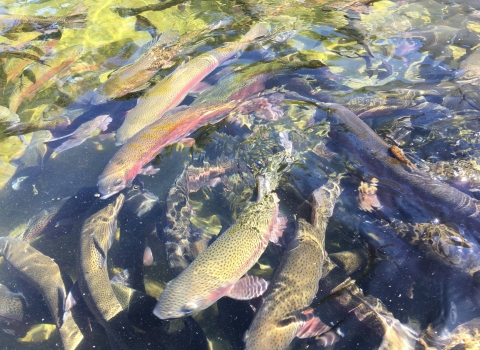Millions of migratory birds are coming back to Alaska from far-flung places. Each spring, these birds return to Alaska to lay eggs and raise young. According to biologists with the U.S. Fish and Wildlife Service, the birds travel to Alaska from wintering grounds as far away as Southeast Asia, South America, the lower 48, Hawaii, and even New Zealand. "The recent discovery of the movements of a peregrine falcon shows the great distances Alaskas migratory birds travel," said Brad Andres, a Service biologist. "A single female peregrine equipped with a satellite transmitter traveled more than 11,000 miles and crossed ten countries between her wintering grounds in Argentina and her breeding grounds in central Alaska.
This year, International Migratory Bird Day celebrates the recovery of the peregrine falcon, which has rebounded from near extinction 30 years ago. Last fall the peregrine falcon was removed from the list of endangered and threatened species, marking a dramatic wildlife success story.
Brad Andres and others will help the public learn about Alaskas birds during the International Migratory Bird Day festival. There will be a 3K Wild Run, exhibits, bird banding, birding field trips, and lots of kids activities. Four bald eagles will be released back to the wild during the day, and a participant from the Wild Run will be chosen to release one of them.
MEDIA ADVISORY
The press is welcome to join the event. Lowell Thomas, Jr., will release one of the bald eagles and the name of a Wild Run participant will be drawn to release another. Falconer Bob Collins will bring his gyrfalcon for a live bird demonstration.
Experts in migratory birds are available for interviews. Please contact Heather Johnson-Schultz in Migratory Bird Management, (907) 786-3367 for interviews and details. For more information on International Migratory Bird Day go online at: http://birds.fws.gov/imbd.html
The U.S. Fish and Wildlife Service is the principal Federal agency responsible for conserving, protecting, and enhancing fish, wildlife and plants and their habitats for the continuing benefit of the American people. The Service manages the 93-million-acre National Wildlife Refuge System comprised of more than 500 national wildlife refuges, thousands of small wetlands, and other special management areas. It also operates 66 national fish hatcheries, 64 fish and wildlife management assistance offices and 78 ecological services field stations. The agency enforces Federal wildlife laws, administers the Endangered Species Act, manages migratory bird populations, restores nationally significant fisheries, conserves and restores wildlife habitat such as wetlands, and helps foreign governments with their conservation efforts. It also oversees the Federal Aid program that distributes hundreds of millions of dollars in excise taxes on fishing and hunting equipment to state wildlife agencies.
You can subscribe to the U.S. Fish and Wildlife Service, Alaska region listserver, to have our press releases sent to your e-mail address automatically by sending an e-mail message to: listserver@www.fws.gov">. Please indicate that you would like to subscribe to FWS-Alaska news and give your name in the body of the message.


